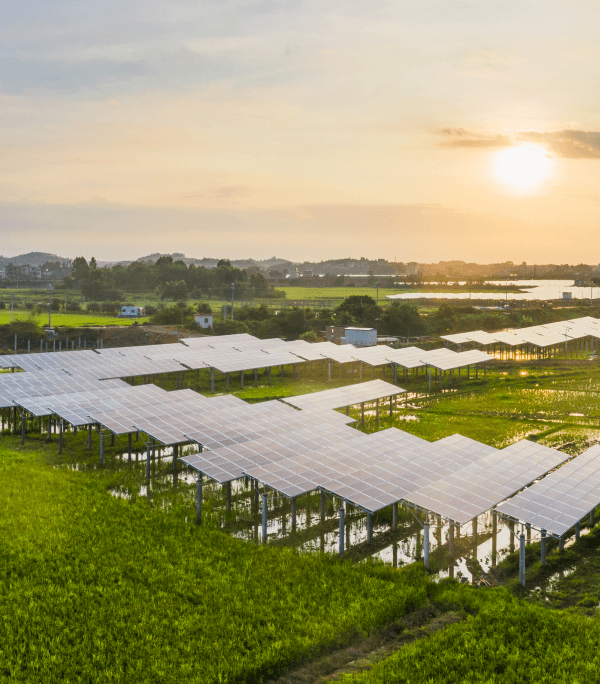Introduction
- In 2024, the US solar industry installed nearly 50 gigawatts direct current (GWdc) of capacity, a 21% increase from 2023. This was the second consecutive year of record-breaking capacity.
- Solar accounted for 66% of all new electricity-generating capacity added to the US grid in 2024, as the industry continued experiencing record growth.
- Domestic module manufacturing capacity grew an unprecedented 190% year-over-year, from just 14.5 GW at the end of 2023 to 42.1 GW at the end of 2024 and surpassed 50 GW in early 2025. This manufacturing is largely concentrated in the South, with 8.6 GW of capacity in Texas and 8.4 GW in Georgia. In 2024, cell manufacturing was reshored for the first time in five years as Suniva restarted production at its 1 GW factory in Georgia.
- In 2024, Texas maintained its position as the top-ranked state for new solar capacity installed for the second consecutive year, with 11.6 GWdc. California narrowly beat Florida for the second position, driven by significant installation volumes in the utility-scale and commercial segments.
- The residential segment installed 4,710 MWdc in 2024, a 32% decline from 2023. This was the segment’s lowest year of installed capacity since 2021, contributing to and impacted by company bankruptcies, sustained high interest rates, and consumer hesitancy ahead of the 2024 election. Forty-two states experienced annual contractions in capacity, with California declining by 45% year-over-year due to the net billing transition.
- The commercial solar segment installed 2,118 MWdc in 2024, setting an annual record with 8% year-over-year growth. Strong deployments in California, Illinois, New York, and Maine contributed to a solid fourth quarter to round out the year.
- The community solar segment installed 1,745 MWdc in 2024, marking its largest-ever year of capacity and a remarkable 35% increase over 2023. This growth was driven by record-breaking capacity additions in New York, Maine, and Illinois. Capacity in New York reached 861 MWdc, a 66% increase year-over-year as interconnection conditions improved.
- The utility-scale segment installed a record-breaking 41.4 GWdc in 2024, 33% year-over-year growth and the second consecutive annual record. Developers installed more than 16 GWdc in Q4 alone. More than a quarter of the nation’s capacity was installed in Texas.
- Our annual Year in review report includes a 10-year outlook for every segment. We expect cumulative US solar capacity to more than triple from 236 GWdc installed at year-end 2024, to 739 GWdc installed by 2035, with average annual capacity additions of more than 45 GWdc. This outlook is based on available information at the time of report publication.
- In the Year in review report, we also include our alternative scenarios (a High and Low case). Amidst considerable policy uncertainty, these scenarios consider different outcomes related to tax credit and tax equity availability, supply chain dynamics, interconnection, retail rate trends, federal and state policy, and the trajectory of interest rates. More details and data can be found in the full report.
Solar Cheat Sheet
-
Current Solar Capacity:
235.7 GW
-
Total Solar Jobs:
279,447
-
Value of Solar Market in 2024:
$70.4 billion
-
Number of U.S. Solar Businesses:
10,000+
-
Total Solar Systems Installed in the U.S.:
5,425,045
-
States with a Solar or Battery Manufacturing Facility:
41
-
In 2024, a New Project was Installed Every:
54 seconds
-
Enough Solar Installed in the U.S. to Power:
40.7 million homes

VIEW THE PRESS RELEASE
REPORT: Solar Adds More New Capacity to the Grid in 2024 Than Any Energy Technology in the Past Two Decades
The United States installed a record-breaking 50 gigawatts (GW) of new solar capacity in 2024, the largest single year of new capacity added to the grid by any energy technology in over two decades.
Read More ->
more data
Get the Full Report
The full Solar Market Insight Report includes all the data and analysis from our Executive Summary plus incisive, state-level breakdowns of installations, costs, manufacturing and demand projections.
Read More ->
resources
View the SMI Report Archives
Click here to access historical reports covering the solar and storage industry's growth
PAST SMI REPORTS
learn more
About the Report
U.S. Solar Market Insight® is a quarterly publication of the Solar Energy Industries Association (SEIA)® and Wood Mackenzie Power & Renewables.
Read More ->



